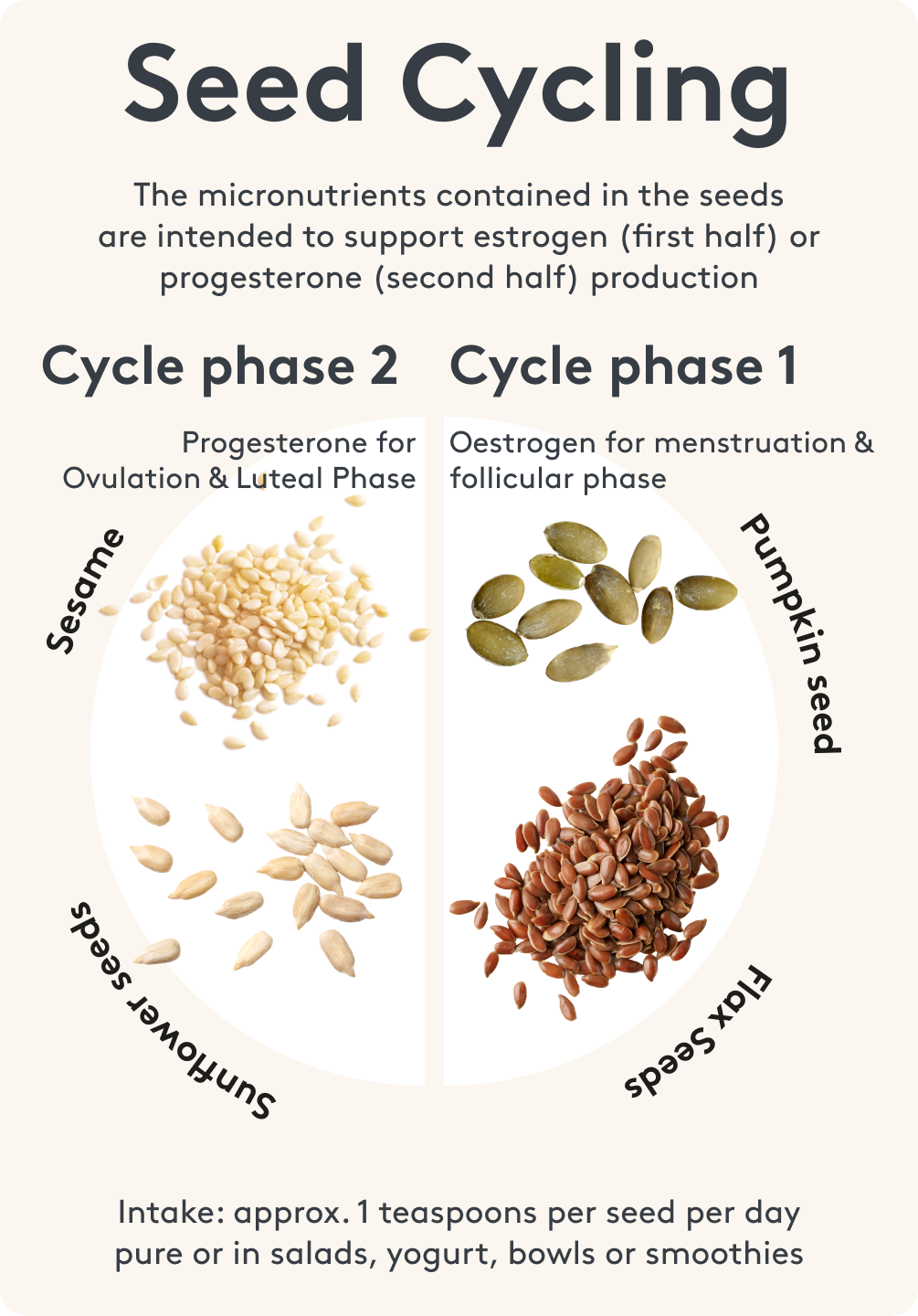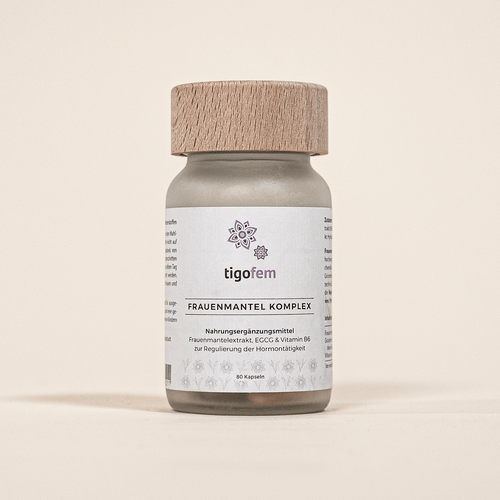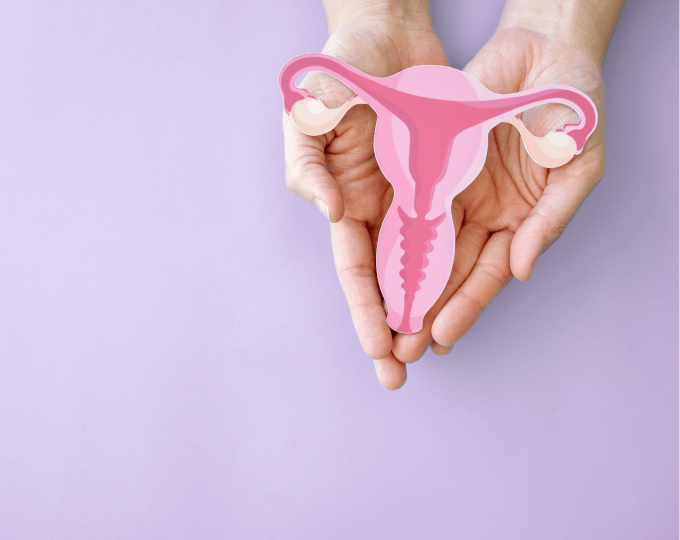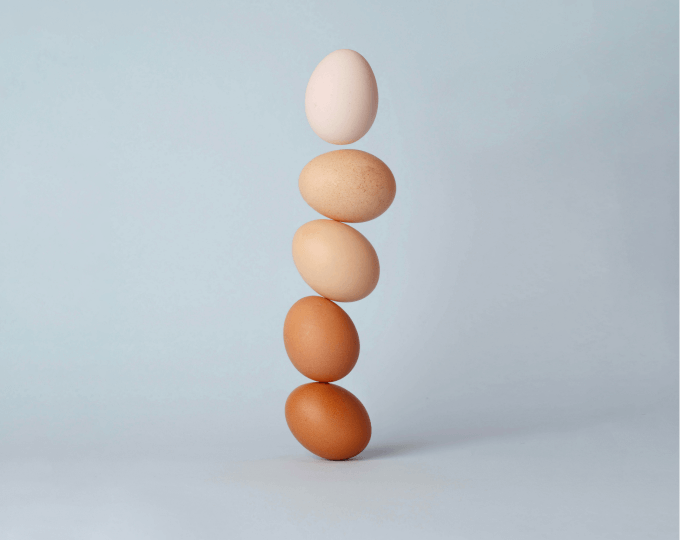Themen dieses Blogartikels:
Table of contents
- The four phases of the cycle explained simply
- What does the body need during your period?
- How can hormonal imbalance manifest itself?
- How your diet affects your period
- You need these 5 micronutrients during your cycle
- What should I eat in which phase of my cycle?
- Menstruation
- Follicular phase
- Ovulation phase
- Luteal phase
- What shouldn't you eat when you're on your period?
- Regulate female hormones naturally: These tips will help you
- What is seed cycling and what does it help with?
- These seeds are eaten during seed cycling
- How does seed cycling work?
- Tips for seed cycling
- Sources & Bibliography
The four phases of the cycle explained simply
Before we look at which foods help to alleviate menstrual cycle symptoms, let's take a brief look at the four phases of the menstrual cycle and how a woman's hormone balance changes during them:
- Menstrual phase (day 1 to 4): The cycle begins with menstrual bleeding. This occurs when the body sheds the lining of the uterus. Hormone levels are low during this phase.
- Follicular phase (day 5 to 14): After menstruation, the body prepares again for a possible pregnancy. The hormone level rises: On the one hand, the body produces follicle-stimulating hormone (FSH). Secondly, the follicles, which are small vesicles surrounding your eggs, release the female sex hormone oestrogen to rebuild the lining of the uterus.
- Ovulation phase (between the 12th and 14th day): The rise in oestrogen stimulates the luteinizing hormone (LH) required for ovulation. The mature egg is transported into the fallopian tube. This is when the chances of getting pregnant are highest.
- Luteal phase (15th to 28th day): In the last phase of the cycle, progesterone levels rise. Alongside oestrogen, progesterone is one of the most important hormones in women. It prepares the lining of the uterus to receive a fertilized egg. If the egg remains unfertilized, the progesterone level drops and menstrual bleeding starts again.
On average, a menstrual cycle lasts 28 days. For some women it is only 21 days, for others 35 or more and for others menstruation comes and goes irregularly. Fluctuations are normal, as factors such as the psyche and physical condition play a role in the cycle.
What does the body need during your period?
During the cycle, the body relies on a balanced hormone balance. Exercise and diet help to provide your body with important nutrients in every phase of your cycle and get it through the cycle with as few symptoms as possible.
An unbalanced diet, stress, the pill or too little exercise, on the other hand, can throw your progesterone and oestrogen out of balance. This can result in hormonal fluctuations.
How can hormonal imbalance manifest itself?
Fluctuations in hormone levels are considered a possible trigger for PMS (premenstrual syndrome), which manifests itself in mood swings, exhaustion, irritability or depression.
If you are often overwhelmed by tiredness, suffer from sleep disorders, are annoyed by hair loss or acne or have headaches that make you lose concentration, these could also be signs of PMS or a hormonal imbalance.
How your diet affects your period
Low calcium and vitamin D levels during the luteal phase of the menstrual cycle can have an impact on PMS and worsen the symptoms.1 You can counteract this with a conscious diet and provide your body with relevant nutrients.
You need these 5 micronutrients during your cycle
- Iron: This mineral is involved in the development of red blood cells, oxygen transport and energy metabolism. Adolescents and women who are menstruating, as well as pregnant women, need more iron than men to prevent iron deficiency.
- Folic acid: This B vitamin is particularly important for pregnant women and is needed for cell division, among other things. However, the body is also dependent on it without pregnancy during the follicular phase.
- Vitamin D: The "sun hormone" regulates insulin levels and is particularly important for active women.
- Calcium: The mineral calcium contributes to your bone health and supports energy metabolism.2
- Magnesium: The bulk element magnesium can help against tiredness and cramps. It strengthens the muscles and is involved in energy metabolism.3, 4
Important: Everyone has different nutrient requirements. If you want to alleviate menstrual cramps or change your diet, you should first speak to your doctor or a nutrition expert.
What should I eat in which phase of my cycle?
If you eat a balanced diet, your body automatically receives many important nutrients. In certain phases of the female cycle, however, it may be advisable to help out. The following foods are suitable for this.
Menstruation
Are you often plagued by cramps and cravings for fatty or sugary foods in the first phase of your cycle? Treat your body to the following foods instead to alleviate typical symptoms during your period:
- Healthy fats - you can find out what these are in our article on fats and oils
- Vitamin A from carrots, pumpkin and sweet potatoes can support hormone metabolism
- Magnesium-rich foods such as nuts, pulses and wholegrain products
- Zinc and iron-rich foods such as oatmeal, millet, quinoa, lentils, linseed, red meat in moderation and leafy vegetables - vitamin C also helps to improve iron absorption
- Omega-3 fatty acids, which have anti-inflammatory properties and can help with cramps - they are found in salmon and certain nuts, among other things
Warm dishes can also help to relieve cramps and increase well-being.
Follicular phase
Once you have overcome your period pains, your energy levels will rise again, as will your oestrogen levels. If you want to use the momentum and exercise now, raw vegetables and crunchy salads are ideal, and probiotic foods and proteins are the best companions for this phase. Supplement your diet with, for example
- sprouts
- pulses
- meat
- cheese or dairy products
- Fermented foods such as sauerkraut or kimchi
Ovulation phase
Ovulation marks the shortest part of your cycle. Nevertheless, it is important to ensure that your hormones are balanced during this phase too. Ingredients with a positive effect on ovulation include
- antioxidants, which are found in wholegrain products such as oats or in spices such as turmeric.5
- Fiber, which you can get from vegetables, fresh fruit and berries
Luteal phase
For many cycles, this is the phase in which PMS can really disrupt everyday life. To ensure more balance, include the following foods in your diet:
- Omega-3-rich foods such as lentils, linseed, wholegrain products
- Green vegetables
- Foods such as oatmeal, bananas, pulses and wholegrain products - they provide important B vitamins
In the second half of the cycle, the liver is busy breaking down the oestrogen again. You can support this process with foods containing vitamin A.
What shouldn't you eat when you're on your period?
These foods should only be consumed in small quantities during menstruation:
- Coffee can inhibit the absorption of iron, increase blood pressure and affect oestrogen levels.6
- Alcohol can exacerbate PMS symptoms7
- Sugar affects blood sugar levels and causes cravings - if the temptation is too great and your body craves chocolate, reach for dark chocolate if possible
- Salt can promote water retention during the cycle
What you should never forget to do in the first and second half of your cycle is to drink enough water.
Regulate female hormones naturally: These tips will help you
In addition to your diet, exercise contributes to the gentle regulation of your hormone balance during your cycle.
In our knowledge blog, you will find valuable tips on how to optimize your training for your cycle. Find out everything you need to know about how your cycle and exercise are connected.
If you don't feel like exercising, you can try out relaxation techniques or make yourself comfortable with a hormone tea. Excessive stress levels are suspected of increasing menstrual pain. Incidentally, according to a study, tea has positive effects on women suffering from polycystic ovary syndrome (PCOS) - a gynecological disease that is believed to be caused by hormonal imbalances.8
Another way to contribute to greater well-being during the phases of your cycle is so-called seed cycling.
Anzeige
- Speziell für Frauengesundheit & das Hormonsystem entwickelt
- Mit den Premium Naturstoffen Ashwagandha, Grüntee-Extrakt (EGCG), Astaxanthin & Dong Quai
- Ergänzt durch Vitamin B6 & Pantothensäure zur Hormonregulierung
- Ohne Füllstoffe oder Aromen
- Mit Ärzten & Experten entwickelt
- Leckerer Geschmack
- Leicht dosierbares Flüssigprodukt

What is seed cycling and what does it help with?
Seed cycling or seed rotation is a method of naturally bringing more regularity to the menstrual cycle. Among other things, seed cycling is said to help gently balance the hormonal system, especially the hormones oestrogen and progesterone.
Seed cycling is also said to help with menstrual cramps. During the menopause, it can help to alleviate hot flushes. Some sources report that seed cycling could have a positive influence on fertility.
These seeds are eaten during seed cycling
The concept involves the consumption of oilseeds, i.e. certain seeds and kernels that contain, among other things, the plant estrogens lignans. These oilseeds are
- pumpkin seeds
- flaxseeds
- sesame seeds
- sunflower seeds
There is as yet no scientific evidence for the effectiveness of seed cycling. However, many women have had good experiences with it. In addition, the seeds and kernels used are full of ingredients that the body can use an extra portion of, especially during the menstrual phase. The only thing to bear in mind is that oilseeds contain more calories than other foods.
How does seed cycling work?
In order for the seeds to develop their positive effect, you should eat them well crushed. It is also important to adapt the type of seeds to your cycle phase. This is how it works:
- Day 1 to 14: In the first half of the cycle, seed cycling recommends eating one tablespoon of flaxseed and one tablespoon of pumpkin seeds every day.
- Day 15 to 28: In the second phase of the cycle, switch to one tablespoon of sunflower seeds and one tablespoon of sesame seeds.


Tips for seed cycling
Do you want variety with seed cycling? Then integrate the seeds creatively into your diet. Use them as a topping for your muesli or salad, for example. Or you can process them together with soaked dates and baking cocoa to make energy balls. You can find various recipes for this online.
The best way to know which seeds and kernels your body needs is to track your period with a smartwatch or cycle app. LadyCycle, for example, is free to use, but only with Android devices. For iPhone users, there are the paid apps Ovolution and Lively.
This article is based on carefully researched sources:
Sources & Bibliography
Sources
Bibliography
- Abdi F, Ozgoli G, Rahnemaie FS. A systematic review of the role of vitamin D and calcium in premenstrual syndrome [published correction appears in Obstet Gynecol Sci. 2020 Mar;63(2):213]. Obstet Gynecol Sci. 2019;62(2):73-86. doi:10.5468/ogs.2019.62.2.73
- Masoumi SZ, Ataollahi M, Oshvandi K. Effect of combined use of calcium and vitamin B6 on premenstrual syndrome symptoms: a randomized clinical trial. J Caring Sci. 2016;5(1):67-73. Published 2016 Mar 1. doi:10.15171/jcs.2016.007
- Parazzini F, Di Martino M, Pellegrino P. Magnesium in the gynecological practice: a literature review. Magnesium in the gynecological practice: a literature review. Magnes Res. 2017;30(1):1-7. doi:10.1684/mrh.2017.0419
- Fathizadeh N, Ebrahimi E, Valiani M, Tavakoli N, Yar MH. Evaluating the effect of magnesium and magnesium plus vitamin B6 supplement on the severity of premenstrual syndrome. Iran J Nurs Midwifery Res. 2010;15(Suppl 1):401-405.
- Shen W, Pan Y, Jin B, et al. Effects of Tea Consumption on Anthropometric Parameters, Metabolic Indexes and Hormone Levels of Women with Polycystic Ovarian Syndrome: A Systematic Review and Meta-Analysis of Randomized Controlled Trials. Front Endocrinol (Lausanne). 2021;12:736867. Published 2021 Dec 13. doi:10.3389/fendo.2021.736867
- Schliep KC, Schisterman EF, Wactawski-Wende J, Perkins NJ, Radin RG, Zarek SM, Mitchell EM, Sjaarda LA, Mumford SL. Serum caffeine and paraxanthine concentrations and menstrual cycle function: correlations with beverage intakes and associations with race, reproductive hormones, and anovulation in the BioCycle Study. At J Clin Nutr. 2016 Jul;104(1):155-63. doi: 10.3945/ajcn.115.118430. Epub 2016 May 25. PMID: 27225433; PMCID: PMC4919523.
- Fernández MDM, Saulyte J, Inskip HM, et alPremenstrual syndrome and alcohol consumption: a systematic review and meta-analysisBMJ Open 2018;8:e019490. doi: 10.1136/bmjopen-2017-019490
- Wang L, Wang X, Wang W, et al. Stress and dysmenorrhea: a population based prospective study. Occup Environ Med. 2004;61(12):1021-1026. doi:10.1136/oem.2003.012302















